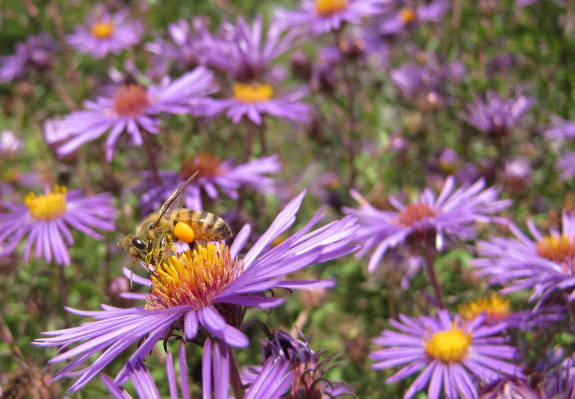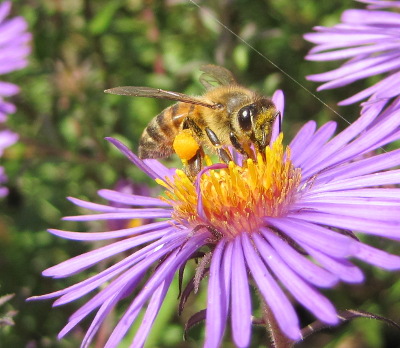
New England asters are a good pollen source

Why were my New
England asters ignored while my mother's neighborhood bees flocked to
her flowers? I
had to look a little closer to solve this two year old puzzle.
 Notice how both girls I
photographed visiting our New England aster this week have full pollen
sacs (the bright yellow lumps on their hind legs)? All of the
bees hunting through our big aster bush were similarly encumbered,
which suggests that the plant species is a great source of pollen, but
not of nectar.
Notice how both girls I
photographed visiting our New England aster this week have full pollen
sacs (the bright yellow lumps on their hind legs)? All of the
bees hunting through our big aster bush were similarly encumbered,
which suggests that the plant species is a great source of pollen, but
not of nectar.
Since ragweed
produces even more pollen, I'm not surprised to find that our bees gave
the New England asters a pass until the better pollen source
faded. That's the same reason they're ignoring my sugar water
feeder and heading straight for the yellow flowers (wingstem, woodland
sunflowers, stick-tights, etc.) in search of nectar.
The upshot is --- if you
need late summer pollen, especially in polished city areas, New England
asters are a good choice. But don't bother if you live in a less
manicured area with lots of wild pollen sources.
Want more in-depth information? Browse through our books.
Or explore more posts by date or by subject.
About us: Anna Hess and Mark Hamilton spent over a decade living self-sufficiently in the mountains of Virginia before moving north to start over from scratch in the foothills of Ohio. They've experimented with permaculture, no-till gardening, trailersteading, home-based microbusinesses and much more, writing about their adventures in both blogs and books.
Want to be notified when new comments are posted on this page? Click on the RSS button after you add a comment to subscribe to the comment feed, or simply check the box beside "email replies to me" while writing your comment.
- Remove comment
- Remove comment
- Remove comment
 )
)
- Remove comment
